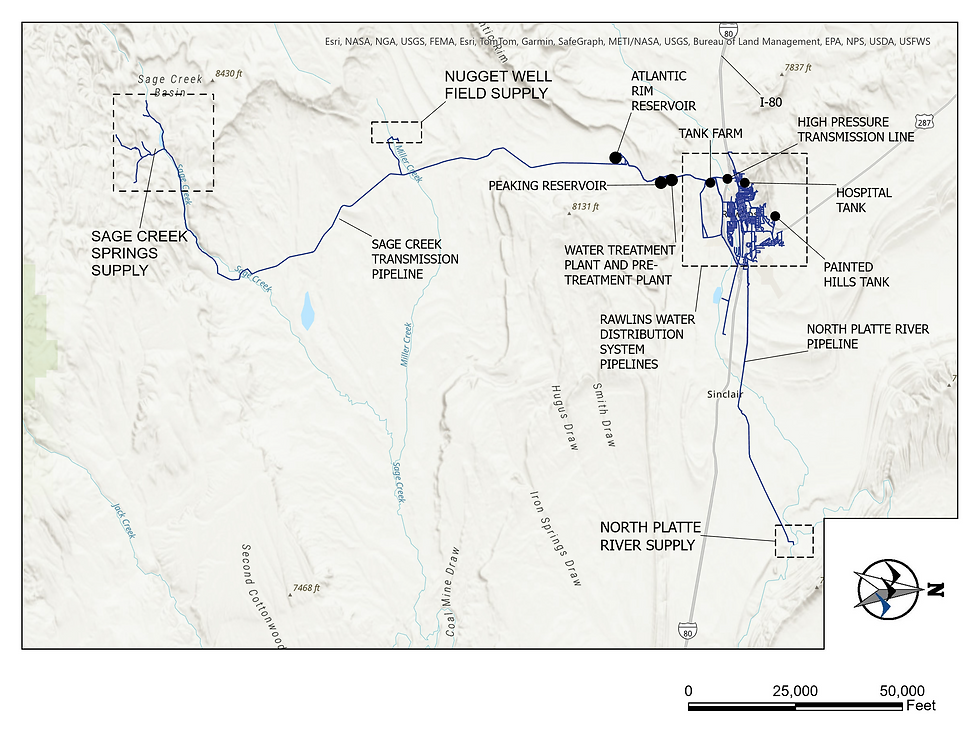Overcoming a water crisis in 2022
- rachel9054
- Jan 1, 2023
- 4 min read
Updated: Dec 6, 2024

Rawlins and neighboring Sinclair faced a severe water crisis in March 2022. A critical infrastructure failure led to depleted water tanks and a boil-water advisory, underscoring the fragility of the area’s aging water system. Here's a look back at the crisis, the community's response, and plans to secure a sustainable water future.
What Happened During the Critical Water Event?
On March 3, 2022, residents of Rawlins and Sinclair were alerted about dangerously low water levels in the city’s tanks. Compounding problems with decaying infrastructure and unexpected leaks had drastically reduced water flow to the treatment plant. A key pipeline failure, combined with unprepared response capacities, led to a loss of water pressure, necessitating an EPA-mandated boil water advisory.
The warnings required residents to conserve water immediately, but it took days to restore supply levels. Water tank levels dropped so critically that even life-essential services were at risk, putting a spotlight on just how strained the local water infrastructure had become.
A Community United
During this ordeal, the community demonstrated incredible resilience and cooperation. Volunteers, local officials, and emergency services worked around the clock to ensure that everyone had access to essential water supplies. Emergency alerts, social media updates, and water distribution efforts kept stakeholders informed and supported. Organizations like the Red Cross, local churches, and private businesses contributed resources, mobilizing to meet the needs of the most vulnerable. Over 99,000 bottles of water were distributed, and emergency call centers staffed by volunteers helped disseminate advisories and updates. Through coordinated conservation efforts, tank levels slowly rose. By mid-March, water services stabilized, and the boil water advisory was lifted.
Challenges Exposed
This event revealed several vulnerabilities in the water system:
Aging Infrastructure: The Sage Creek transmission pipeline, coupled with over 100-year-old wood stave pipelines in Sage Creek Springs, were in dire need of replacement due to leaks and corrosion.
Lack of Modern Maintenance: Air-vacuum valves and blowoff valves critical to maintaining water flow had not been properly maintained or replaced in decades.
Supply-Demand Gaps: While summer water usage skyrocketed to 4-6 million gallons daily, the water treatment plant struggled to treat turbid reservoir water and meet demand.
While interim repairs were made, systemic issues remained, with experts warning that a fully updated system would take 3-5 years to implement.
Infrastructure Updates
A critical focus for Rawlins was upgrading its aging water infrastructure to ensure a stable water supply. Key projects included:
Pipeline Replacement: Work was done to replace 10,000 feet of the woodstave pipeline in the Sage Creek Basin with a new PVC pipeline to improve water flow and reliability. While the transition encountered setbacks, such as turbid water flow and valve failures, the shift to PVC was a significant step forward.
Pretreatment Plant: Repairs and equipment replacements at the Pretreatment Plant continued to address water quality and treatment challenges. Although the reactivation of the plant did not occur during this watering season, it was seen as a vital piece of the city's long-term water strategy.
Steel Pipeline Repairs: The design and construction of blowoffs and cathodic protection for the Sage Creekl transmission line were being reviewed. Repairs would extend the lifespan of critical infrastructure.
Water Restrictions
Conservation efforts became a necessity as the city struggled to maintain adequate tank levels due to reduced spring flows:
Outdoor irrigation was limited to once per week, with further restrictions during critical periods. Lawns were deprioritized in favor of gardens and trees, and parks ceased watering entirely at times.
Residents were encouraged to adopt water-saving practices such as limiting laundry and dishwashing to reduce strain on the supply.
Funding Efforts
To finance these repairs and improvements, Rawlins actively pursued funding through various grants and loans:
A $675,000 State Land and Investment Board (SLIB) grant was secured for steel pipeline repair designs.
Additional grant applications, including a $7.5 million ARPA Stimulus Grant and USDA Rural Development loan, were in progress. These funds would help tackle larger projects like spring box replacement and other major repairs.
The city allocated funds internally, using impact assistance from local industries and loans to kickstart projects while awaiting external funding.
Engaging the Community
Transparency and public participation were central to Rawlins' response to these challenges:
A Water Rate Study was conducted to evaluate fair pricing for services while ensuring funds for infrastructure maintenance. Public hearings, work sessions, and surveys invited community feedback on proposed rate adjustments, which may raise the average household water bill by $20 a month.
Residents were routinely updated on developments through weekly reports, live video Q&A sessions, and detailed data shared online.
The city hosted town halls in collaboration with local experts to educate citizens on water conservation practices and explain ongoing restrictions.
Addressing Challenges
The fragility of Rawlins' water system has highlighted the dire need for widespread upgrades:
Unforeseen issues like valve failures and turbid water slowed progress, while drought conditions further strained resources.
Infrastructure improvements, such as the new PVC pipeline and planned cathodic protection for steel lines, promise long-term benefits but require careful planning and execution.
Looking Ahead
With resilience and collaboration, Rawlins is tackling its water supply and infrastructure issues head-on. Progress was made in 2022, but the road ahead still demands community cooperation and significant funding. The city is laying the foundation for a more sustainable and reliable water future by continuing to engage its citizens and prioritize essential repairs.




